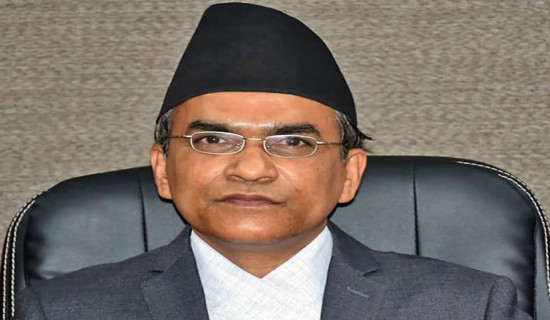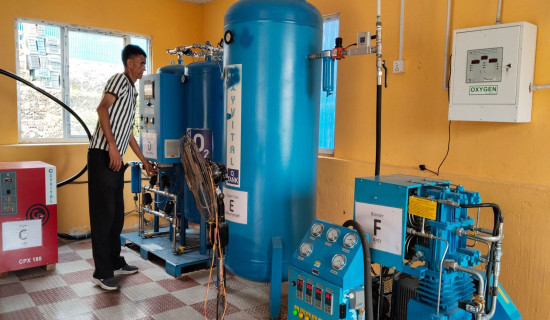- Tuesday, 10 June 2025
Pokhara emerges as hub of indigenous Gurung films
By Santosh Subedi,Kaski, June 10: More movies based on indigenous culture, art, language, traditions, attire, and music are being produced in Pokhara.
Charity shows of Gurung-language films are frequently held in local cinemas, making Pokhara a fertile ground for Gurungs’ cinema.
Over the 27 years, many Gurung films have been produced, and the trend continues to flourish.
It all started around 1995 when an organisation, Rodhi Pariwar, was established by Gurung youth, initially focusing on singing and dancing. The group eventually ventured into filmmaking almost playfully. Among these youth was Pritam Gurung, who would go on to become the lead actor in the first Gurung-language film. However, they faced a major hurdle in funding.
Pritam sought money from his parents to produce the film. The film was titled ‘Pate’ (Younger Daughter).
The film's auspicious inaugural ceremony was graced by Melissa Lee, a researcher from Singapore who had come to Nepal to study Gurung language and culture.
Prior to this, Yuv Raj Maski Magar made the first Magar-language film ‘Langlan’.
Yuv Raj also directed Pate. Pritam Gurung played the lead role, and Anu Gurung played the female lead. According to Pritam, the total investment was about Rs. 500,000.
“The investment was entirely personal, and we didn’t recover the money immediately,” he recalls. “Charity shows weren’t a thing back then. We used to sit in tents and sell VHS tapes and cassettes.”
Shooting of Pate began in 1995 at Khandani, Tanahun and Kathmandu, and it was completed in 26 days. The film was later broadcast on Nepal Television in episodes during the National Education Day celebration in 1998. But even from the television, they did not receive the promised amount.
“We only got about Rs. 35,000 , although the agreed amount was higher,” Pritam said.
Pate was dubbed in both Gurung and Nepali languages, making it accessible to non-Gurung audiences as well. Apart from Pritam, the producers included Mahesh Gurung and Sherjang Gurung.
This film sparked a wave of enthusiasm among Gurung filmmakers, a momentum that continues to this day. In 2015, Pritam even produced a sequel-- Pate 2.
A fully Gurung-language film titled Nhyam Syo Nhyori was directed by Min Bahadur Gurung. It was written by Lok Bahadur Gurung.
Gole Gurung, primarily known for his choreography, created a film titled ‘Bideshko Mato, Swadeshko Pida’ and played the lead role himself. He also produced other titles such as Phechhe, Bacha Bandhan, and Herne Ta.
Once these early films emerged, language-based films began to be seen with growing importance.
Lok Bahadur Gurung and Ved Bahadur Gurung (Shyam) collaborated on films like Ngoye Nasa To, Herbei Ta, Phresyo, and Dhing.
With the aim of spreading their language and culture both nationally and internationally, the production of Gurung-language films became a popular practice. Around 15 such films are produced each year in Nepal alone.
Among indigenous films, those in the Gurung language dominate in number. In these 27 years, Gurung cinema has made significant progress.
Over 200 Gurung-language films have been produced, and several others are still under production. Most filmmakers and film shoots are concentrated in the Gandaki region.
To support Gurung films and filmmakers, the Gurung Film Association (GIFAN) was established in 2008. It has helped not only in producing films but also in preserving and showcasing Gurung art and culture. According to GIFAN's founding president, Maotse Gurung, the organisation aims to educate the younger generation about Gurung customs and traditions.
A few films have even been released in theatres through the queue system. One such film, Nakai Fhun directed and produced by Maotse Gurung, collected Rs. 500,000 from its theatrical release.
Gurung cinema has grown not only in volume but also in quality. Today, it is mandatory to get approval from the Film Development Board before shooting. Additionally, GIFAN also requires registration. Without passing censorship, films cannot be screened, which has helped stop the production of substandard films.
Maotse Gurung recalls the early days when films were shot with HS9000 cameras, and editing and dubbing were tedious.
“There’s a huge difference between Gurung films back then and now,” he said. Technological advancements have given a major boost to the industry. Nowadays, films are shot digitally using DSLR, GH4, and 7D cameras.
















